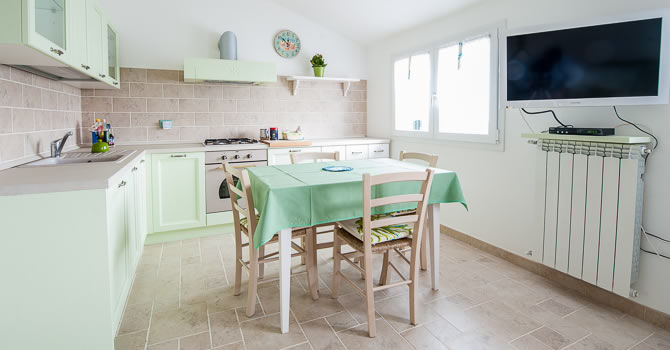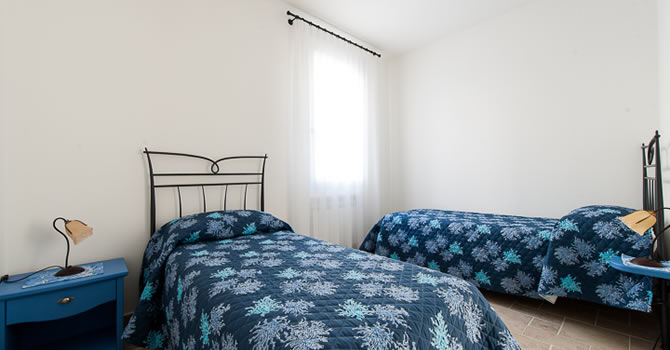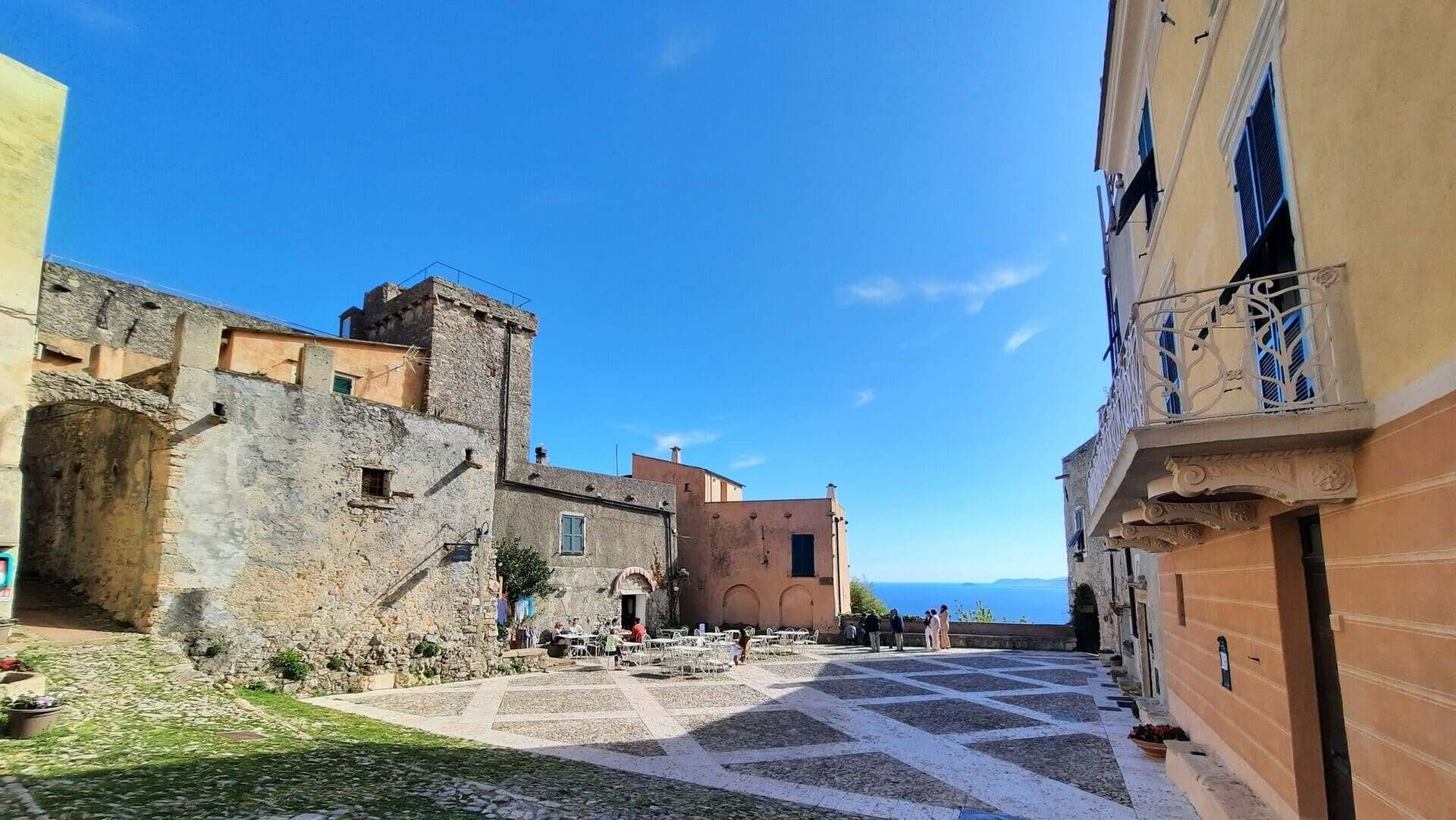
Villages of Liguria
What to see in Borgio Verezzi: the paths and hamlets
October 13, 2023
- How to get to Borgio Verezzi by car
- Reaching Borgio Verezzi on foot: trails and hiking
- The Geological Trail
- The Nature Trail
- The Culture Trail
- The history of the village
- The hamlets
- Poggio hamlet and the old quarry
- Borgata Piazza
- Borgata Roccaro
- Borgata Crosa and its caves
- What to do in Verezzi: visit churches and the Phoenician mill
- The Church of San Martino
- The Phoenician Mill
In the heart of the province of Savona, in beautiful western Liguria, lies the village of Borgio Verezzi, able to fascinate with its historic architecture and striking panoramic views of the Ligurian Sea. What to see in Borgio Verezzi? From the picturesque village center to the famous caves, there is certainly no shortage of attractions. Here are some suggestions for visiting.
How to get to Borgio Verezzi by car[ back to menu ]
Borgio Verezzi is located at a distance of about 45 km from Diano Marina. Our farmhouse once again lends itself to exploring the beauty of the area: discover our vacation apartments in western Liguria.
To reach the village, simply take the A10 highway to Pietra Ligure, then continue on the SS1 Via Aurelia to Verezzi. Once you arrive at your destination you can find both free and paid parking lots.
Reaching Borgio Verezzi on foot: trails and hiking[ back to menu ]
For those who wish to avoid the last stretch of the narrower and more winding main road, there is a more scenic and fascinating alternative. In fact, it is possible to ascend to the village on foot via Via Dei Pasti, walking along the charming Geological Trail, reaching the first hamlet of Verezzi, known as Borgata Poggio. Here is a quick overview of the main paths that pass through the village.
The Geological Trail [ back to menu ]
The Geological Trail is a fascinating thematic trail that provides an extraordinary journey through hundreds of millions of years of geological history in the Borgio Verezzi area. This trail, starting and ending at the Borgio Verezzi Caves, stretches for 6 km with an elevation gain of 310 meters. Along the trail, six descriptive panels provide detailed information on the various geological events that have shaped the surrounding area over time.

The journey begins well over 300 million years ago, when the first rocks were formed, and extends to the present day. From the starting point near the Caves, the trail climbs along a paved road, following the ridge that leads to the Bastia Tower. Next, we cross the Rio Battorezza and reach Roccaro, where it is possible to understand the genesis of the oldest rocks on the trail, with a time span ranging from 300 to 35 million years ago. You then pass by the Sassetti Tower and have the opportunity to observe a fossil beach dating back 30 million years.
Continuing on the trail, you climb toward Crosa, meet a washhouse and continue left toward Arma Crosa, finally reaching the top of the plateau. In this part of the trail, you can admire the formation of the beautiful Verezzi stone. The walk continues northwest along the ancient Via del Castellaro, and then back toward Verezzi on a dirt road that passes near a dolmen.
You finally reach the Church of San Martino, from which you descend into the dolmen to reach the ancient quarry on the Orera plateau. From here, the trail ascends to the church and then descends along the Via della Ciappa, passing near the most recent quarry on the hill, to finally reach Poggio. From Poggio, following the Via dei Pasti, you descend back to Borgio, thus completing the impressive geological trail and returning to the starting point at the Borgio Verezzi Caves.
Walking along the geological trail in Borgio Verezzi
The Nature Trail[ back to menu ]
The Nature Trail is an equipped thematic path that allows visitors to discover the natural environments that characterize the area, exploring their geological, botanic, faunal and anthropic features through 15 informative explanatory panels.
The itinerary begins at the Borgio level crossing, from where you take Via Nazario Sauro and then Via della Cornice, passing through a forest of Aleppo pines and a stretch of scented garrigue. Along the way, you reach the ancient stone quarries of Verezzi, rich in fossils, where the first picnic area is located.
Continuing to climb toward the Church of San Martino, you cross the typical Mediterranean scrub, an ilex grove. You pass near the Phoenician Mill, where there is an interesting viewpoint, before descending to Crosa.
The path continues to Piazza and then to the hamlet of Roccaro and to the Carob Mount Trivio del Carrubo del Buongiorno. From here, along Via Varicella, it descends to Borgio crossing the Rio Battorezza. Along the way, you can encounter the second equipped area in the public park of the former aqueduct, and after crossing Piazza San Pietro, you finally reach the Borgio Verezzi Caves.
The Culture Trail[ back to menu ]
The Culture Trail winds through the main sites of cultural interest in the area, delving into their historical and architectural features through 12 descriptive panels. This trail begins in the hamlet of Crosa and extends for about 3 km, with an elevation gain of 170 meters.

From Crosa, the trail initially leads uphill to the Church of San Martino, then continues in the direction of the sea along a ridge. Along the way, you reach the beautiful cliff overlooking the sea, with spectacular views ranging from Gallinara Island to Genoa and, on clear days, even beyond to Corsica.
Next, you descend into the quarry area and approach the settlements of Verezzi, stopping first in the hamlet of Poggio. Continuing, you descend further to the junction of Carrubbo del Buongiorno, an ancient meeting and exchange place between the burghers and the Verezzini. From this point, the route of the Culture Trail coincides with that of the Nature Trail, following it in the opposite direction until returning to the starting point in Crosa.
The history of the village[ back to menu ]
History, or rather theories about the birth of the village, narrate that Verezzi, like Varigotti, was founded by Saracens. However, this theory is not completely accurate. It is more likely that the construction methods used in the Middle East were introduced by masons and builders of Arab origin who converted to Christianity, by local prisoners who were either ransomed or escaped after many years in those countries, or even by individuals belonging to the Moorish troops who crossed the local coasts and settled permanently in this area. This theory is confirmed by the characteristic architecture of the stone houses, with terraced roofs and interconnected arches, creating an atmosphere of narrow lanes and well-organized underpasses.
For a long period, until the early 1700s, Borgio Verezzi maintained its position as a more populous center than Borgio, thanks mainly to the inhabitants' skill in stone working.
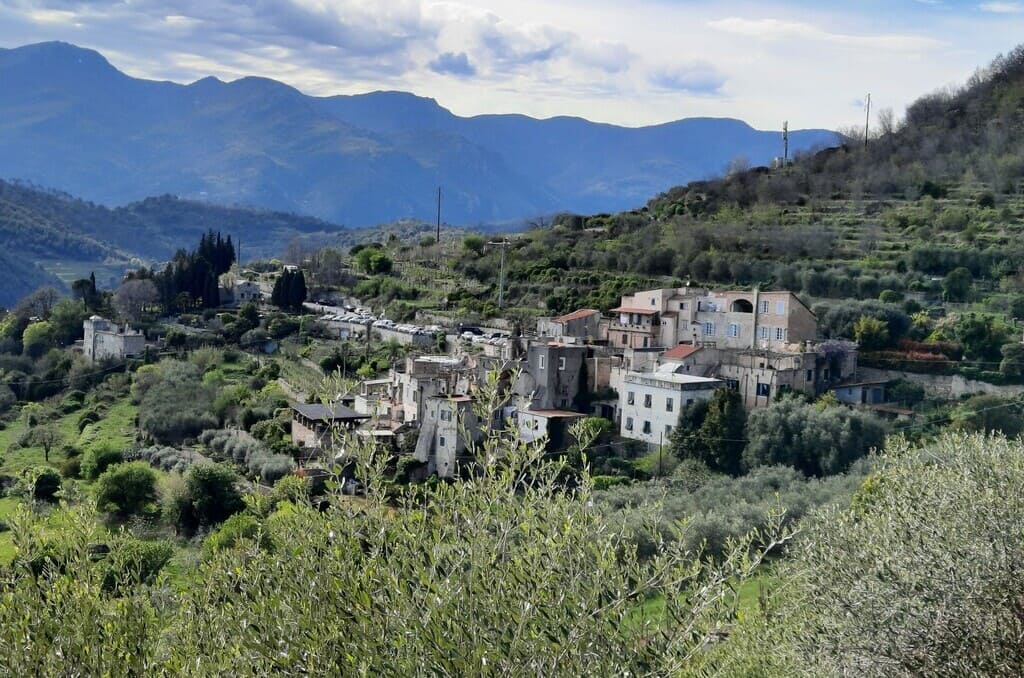
The hamlets [ back to menu ]
The village of Verezzi consists of the hamlets of Poggio, Piazza, Roccaro, and Crosa, and they can all be visited on foot via the Geological Trail. The trail is well marked and offers panoramic views of Borgio and Loano as you progress.
Poggio hamlet and the old quarry[ back to menu ]
In the hamlet of Poggio it is possible to explore the characteristic caruggi. With a little attention, it is possible to spot a doorway that, in perspective, seems to lead directly to the sea, creating a truly striking visual illusion.

Past Poggio, it is possible to explore the old quarry, a place worth visiting both for its breathtaking views and for its historical and archaeological importance.
To reach the quarry, one drives along Via Cava Vecchia, where there is a small parking lot where cars or scooters can be left.

This quarry represents one of the rare examples of stone quarries in the Finale area cultivated in tunnels, similar to the Roman quarries in Val Ponci. Its present form was caused by the collapse of the entire vault, a sudden event that occurred in the late 1930s, which fortunately did not cause any casualties and, therefore, was gradually forgotten.
The quarry was cultivated following the traditional barrel system, where deep vertical grooves were made in the rock bed to isolate a portion of the stone. This portion was then cleared by drilling niches along the sedimentation plane and inserting wooden or metal wedges. In particular, the system involved the use of fig wedges, which were quickly inflated with water to completely detach the boulder from the mountain. Along the quarry walls, parallel marks left by the steel spikes are still visible.
The most experienced workers who worked in this quarry came from the areas of Barge (CN) and the Apuan Alps. Even today, many of the verezzine families are descendants of those skilled workers who contributed to the cultivation of this stone quarry.
The magnificent old quarry in Borgio Verezzi
Borgata Piazza[ back to menu ]
Borgata Piazza is recognized as the main hamlet of Verezzi. At the entrance, there is a large parking lot, over which the flag of Italy's Most Beautiful Villages proudly flies, confirming its beauty and importance.
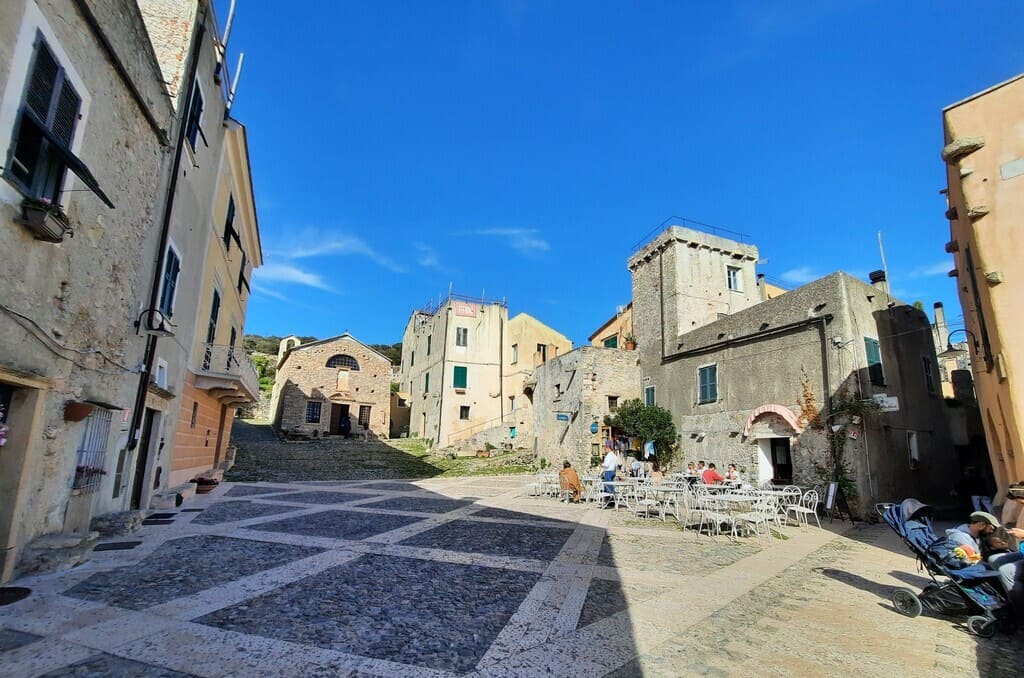
The hamlet is considerably more articulated than Borgata Poggio, as it is filled with souvenir stores, restaurants, and an intricate maze of caruggi. During the summer season, Piazza is the venue for the Verezzi Theater Festival, a tradition now in its 57th year, with performances staged in Piazza di Sant'Agostino. It is from this square that the township takes its name. Piazza di Sant'Agostino was finally enlarged in 1670, when a house owned by B. Aicardo was demolished at a cost of 26 Genoese liras.
Wandering around the hamlet Piazza in Borgio Verezzi
Borgata Roccaro[ back to menu ]
Having passed borgata Piazza, it is possible to reach borgata Roccaro by following the Roccaro Street of the same name. During the short flat stretch, it is possible to admire the charming cultivated vegetable gardens overlooking the sea. It should be noted that the center of this hamlet is accessible only on foot.
Roccaro owes its name to the presence of an imposing rock outcropping on which the houses were built following an arrangement based on two orthogonal axes. These axes intersect at some underpasses, creating a unique and fascinating structure. Roccaro is believed to be the most recent part of Verezzi, and several eighteenth-century villas and holiday homes built with greater attention to architectural detail can be found here. Many of these houses have sundials and coats of arms. Among the houses, it is possible to admire oleander, fig, pittosporum and almond tree plants.
Within this charming hamlet, among the various caruggi and crose, is the privately owned chapel of the Immaculate Conception.
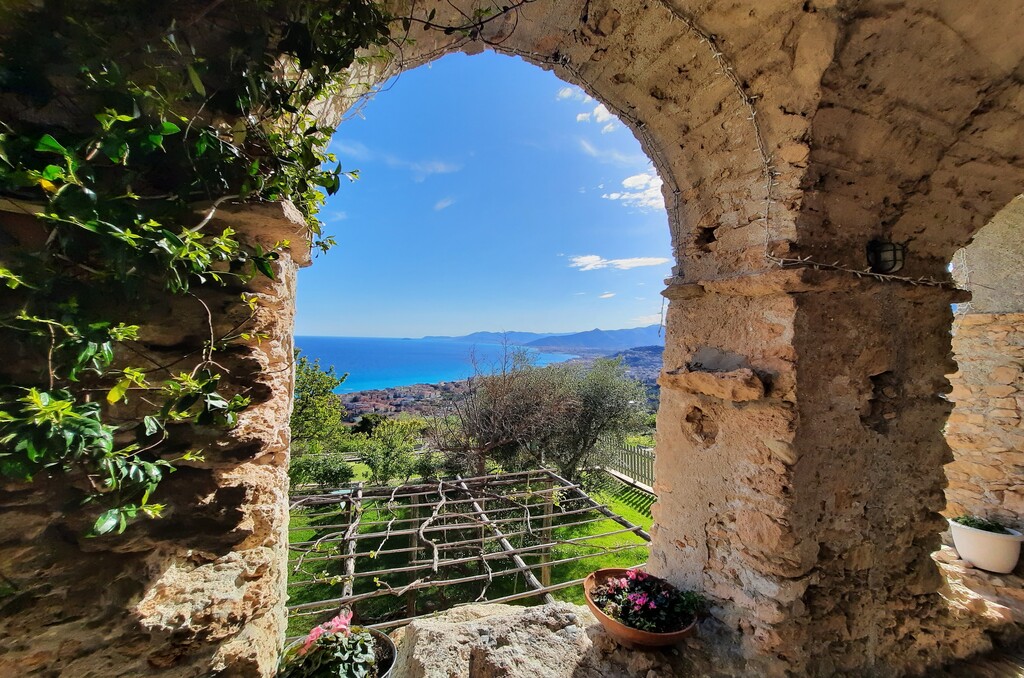
Borgata Crosa and its caves[ back to menu ]
There is ample parking in the vicinity of the Crosa hamlet, but its center cannot be reached by car. The area's churches and Phoenician mill are also accessible only on foot. The name of the hamlet Crosa has Latin origins, and is derived from "corrosa," which indicated an area rich in caves. The caves at the base of the cliff were probably an ideal place for the beginning of human organization of communal life since the Paleolithic period. The entire Finale area is rich in valuable archaeological finds dating back some 300,000 years, now on display at the Finale Civic Museum. The caves at the base of the cliff, in particular, were used over time as storage areas and, with the construction of brick houses, as cellars.
A notable detail is the large wash-house with hand-operated fountain, a meeting and conversation place (ciatessi) found in all the hamlets of Verezzi. During the visit, it is interesting to note that the dry stone walls along the descent to Piazza feature all the types of rock found in the area: dolomite, light gray-green marls consisting of calcareous mudstones, siltstones with a cineritic matrix, and, finally, Verezzi stone.
Within the hamlet of Crosa, it is possible to explore several caruggi: the ideal activity is an immersion in local history and culture, with its ancient caves and traditions well established in the Verezzi area.

What to do in Verezzi: visit churches and the Phoenician mill[ back to menu ]
During a visit to Borgio Verezzi, an essential stop for many is a visit to its fascinating churches and Phoenician mill. Walking down Via della Chiesa, you will have the opportunity to explore the Church of San Martino and then reach the Maria Regina Sanctuary. It is then worth spending time at the Phoenician mill, an authentic historical testimony that connects Verezzi to its millennia-old roots.
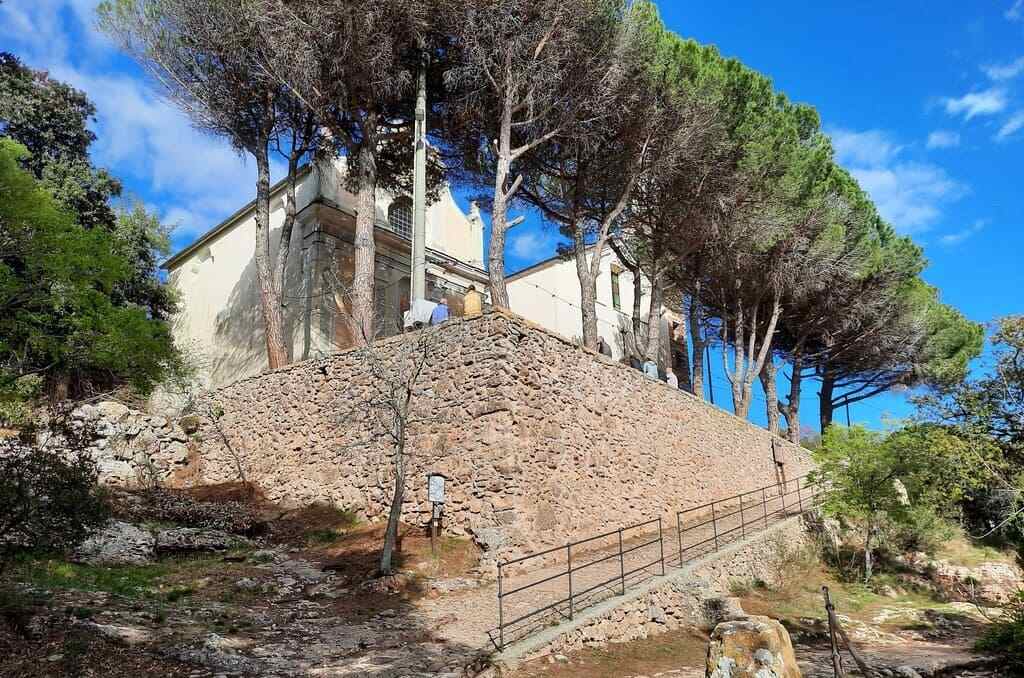
The Church of San Martino[ back to menu ]
The Church of San Martino is a Catholic place of worship located in the hamlet of Verezzi, in the municipality of Borgio Verezzi. This church serves as the seat of the parish of the same name within the pastoral area of Pietra Ligure, within the diocese of Albenga-Imperia.
The church is located just outside the central core of Verezzi and is accessible via a footpath. It was built between 1637 and 1645 on the initiative of prior Giovanni Tommaso Cucchi. For the construction of this new church, the spaces of the previous church of the Disciplinants, which dated back to the 14th and 15th centuries, were used. Some traces of the original church remain in the form of an archway with a fresco depicting St. Peter the Apostle and a Latin inscription from 1612. The church of San Martino thus represents an important religious site with a history intertwined with that of the community of Verezzi.
In front of the church of San Martino stands a majestic bell of considerable size that, for generations, has rung daily at 7 p.m. in a touch commemorating all deceased mothers.

The Phoenician Mill[ back to menu ]
The Phoenician mill represents an unmissable stop in the exploration of Verezzi. Its name derives from its peculiar system of operation, unique in Europe. Currently, only three such mills survive on the continent: one in Spain, one in Sicily (both in a state of ruin), and the Verezzi mill, which is the best preserved.

The mill tower had eight windows, which could be opened or closed at will to allow the wind, harnessed for its operation, to enter. Inside, a vertical shaft was attached at the top of the blades or sails (which could be lowered), transmitting rotary motion through hardwood gears to the milling system, consisting of a fixed base stone and a rotating millstone. Recently, a scale model made by Borgio Old Town was successfully tested in a wind tunnel.
Unfortunately, the windows are currently bricked up, making access to the interior of the mill impossible. Even to glimpse the building among the vegetation, one has to sharpen one's eyes.
Reaching the Phoenician mill at Borgio Verezzi
Listen to all podcasts published on our official channels:
